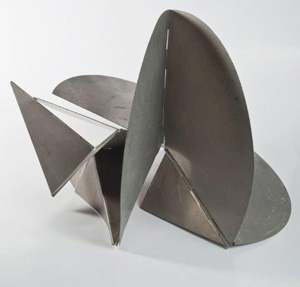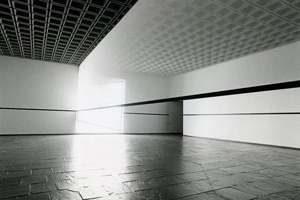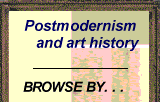Bodily Structures
John Haberin New York City
Lygia Clark and Bill Jenkins
Lygia Clark titled her most extravagant installation A Casa é o Corpo: the house is the body. Not just "my house" or "your house," but the house—and not just "my body" or "your body" but the body. It sounds so much larger than life, but also so close to home.
Clark's exhaustive retrospective all but asks one to move in, long enough to view some three hundred objects, and her signature work invites one to give it shape with one's bare hands. Along the way, Clark starts over again half a dozen times. She studied architecture, but she ended her career with touchy-feely art. Two people entering the galleries from opposite ends could think that they have met two different artists. Did it take her a lifetime to find her way home? A postscript considers Bill Jenkins and others who leave spaces empty but for the body. 
Simplify, complexify
For Lygia Clark, MoMA sees not a lifetime of discovery, but a letting go. It even subtitles the exhibition "The Abandonment of Art." With an arrangement from smaller rooms to a larger one, the opposite direction from several exhibitions, it also tempts one to encounter the Brazilian artist first in Europe in the late 1960s and 1970s, with a display of masks, fabrics, pillows, an elastic net, and metal goggles. They need the space of that room, too, for all these were props for sensory, collective, and participatory art, and museum-goers can join right in. Along with accompanying video, they include perhaps her very last work, Structuring of the Self. She returned to Brazil in 1977 but left little more before her death in 1988.
One entering the proper way will encounter not the abandonment but the structuring. Born in 1920, Clark moved to Rio in 1947 to study with Roberto Burle Marx, the Latin American architect. Her first paintings flirt with abstraction, but to represent stairwells, much like near abstract Brazilian photography of her time. One interior represents a storage rack for canvases, seen from the back. After further studies in Paris, she still moves freely between art and architecture. In a lecture from 1956, she calls on both "to compose space and not compose in it."
She did not have far to look, for Tarsila do Amaral in her native land art since Cubism had been doing just that. In canvases from the early 1950s, her planes spin outward, as for Fernand Léger and Futurism, or reach up to catch the light, as for Paul Klee. Meanwhile her other side is at work on architectural maquettes, with open plans and cantilevers built from matchboxes. Think of Frank Lloyd Wright playing with fire. Looking back, one can see the roots of her later sculpture in the outward motion and the playfulness alike. At each stage, she first modernizes, then simplifies, and then multiplies her designs to infinity before starting over once again.
Soon comes only the first of many decisive breaks, what a 1954 painting calls Breaking the Frame. Now Clark adopts the horizontals, verticals, and asymmetry of Piet Mondrian, in colorful industrial paints, while stepping more fully into space. Some paintings can fold out, with hinges. They also incorporate the "organic lines" that her 1956 lecture compares to doors, windows, and floors. The dualism of house and body, of inorganic and organic form, is already taking shape. She will later call her best-known metal sculpture, also hinged, "critters."
Once again the patterns grow more complicated, with clustered zigzags running every which way, before the urge to simplify kicks in once more. This time Clark strips away not just the repetition, but also the color, leaving only tilted fields of black and white on wood. Naturally these multiply as well, with dozens of variations on a theme in 1957 alone. The next year she is simplifying once more, with the white diagonals reduced to thin lines, while imagining again a third dimension, so that the Planes on Modulated Surfaces become instead Planes in Modulated Spaces or simply Units. Do these works have a parallel in American artists like Ellsworth Kelly? No question, and so do others in Brazilian art, like Hélio Oitaca, Mestre Didi, and Lygia Pape, who saw themselves as working between art and life.
Clark could not identify long with their Neo-Concretism and Grupo Frente, no more than Gego in Venezuela, because she could not identify for long with any movement, not even her own. Still, like Julio Le Parc in Argentina, she joined in their anticipation of Minimalism. Sculpture brings together her elements to date, in repeated units, geometric variations, organic form, and the ambiguity of inside and out. It pushes her into the third dimension for good, first in balsa wood. She was to stick with her "critters" in polished metal for what to her is an eternity, through the early 1960s. If the show quit here, it would end with the triumph of a major artist.
Finding one's way home
Of course, this being Clark, it cannot stop anywhere, but it can take a nice long rest. So large a retrospective can fly by awfully quickly, given works in series—or it can seem to go on forever, and in a way it does. Her polished copper, tin, and steel recall David Smith. Yet she meant anyone to handle them and to refold them freely, for infinite possibilities. They suggest a short history of abstract art, in the form of everything from planetary orbits to living things to space itself—in the words of one title, Monument for All Situations. Other titles allude to crabs, cocoons, flowers, and sundials.
The series title, Bichos, is just as slippery. While the curators, Connie Butler of UCLA's Hammer Museum and Luis Pérez-Oramas, render it as the friendly "critters," others have opted for a more neutral "creatures," and Google Translate returns "bugs" or "vermin." It may be onto something disturbing. Clark's sculpture also extends to boxes spinning out into coils, as one more snake dance of inside and out. But then the treacherous side wins out, with a self-imposed exile in Europe and the retrospective's final room. MoMA sees only abandonment, but she saw her late work as therapy, and it looks ahead to the faddish "relational esthetics" of Rirkrit Tiravanija and others today.
One can see her on video out front, moving between her therapy and her fears. Her eyes masked, she massages a fabric-lined bag holding an egg-shaped stone. One notices at once the sensuality and the nurturing, perhaps self-nurturing, and only later the evasion and disguise. Elsewhere she holds two bags side by side, each filled with water and shells, as if weighing the future. Metal goggles of those same years may promise a clearer vision or dehumanization. She calls one performance Cannibalism, for something is still eating at her core.
With A Casa é o Corpo, a plywood shelter, it can eat away at you, too. Clark described the 1968 installation's chambers as penetration, ovulation, germination, expulsion, like a rebirth, but it is not an easy passage. One enters into darkness, pushes through balloons into the light, drags oneself across a squishy floor, sits in a tent as air makes the floor vibrate, looks for firmer ground amid thread and rubber balls, and exits at last. The house is the body, but does it belong to you or to her? This being New York real estate, it also requires if not a wait list, at least waiting on line. It is worth it, though, in search of not just sensory experience, but also a unity to her career.
Clark called one performance, a shared encounter with translucent nylon and plastic, Biological Architecture. Was her art both biology and architecture all along? One can see the retrospective as a series of smaller shows, with little in common beyond their maker. One can see it as a perpetual reinvention of the self or an absence. One can see it as a story of abandonment and trauma—or the triumph of an artist outside the North American male canon. In "Primary Structures," a breakthrough 1966 exhibition of Minimalism at the Jewish Museum, only three of the forty-two artists were women, of which two are seldom mentioned today.
One can find a winding continuity between her stages—from structure to abstraction, to breaking the frame, to organic line, to nonhuman creatures, to human interactions, to therapeutic recovery, and finally to silence. One can see them all as the evolution from geometry to a Post-Minimalism more closely attuned to the body, like that of Eva Hesse. And the story may matter as much as the art. Clark's work is often way duller than its permutations set out side by side. The "critters" are often reconstructions after her death anyway. At every step the process runs between art, architecture, and the body, daring one to find one's way home.
Beware of darkness
I have been stumbling in the dark a lot lately. I had adjusted to the light for Zoe Leonard and her camera obscura in the 2014 Whitney Biennial, just in time to tumble head first into the house that Clark had designed for penetration, ovulation, germination, [and] expulsion—with expulsion a seemingly distant promise. I had climbed to the top of a carousel in the darkness of twentieth-century German history for Christoph Schlingensief, slipped below Park Avenue and into its Voice Tunnel, and made it through Rain Room without getting wet. Video rooms, too, seem to be growing blacker, with a longer and more treacherous entry. I guess big Chelsea galleries have to find some use for all that space. A team of French artists has even called a display Last Manoeuvres in the Dark.
 I should be grateful to have made it this far in one piece, but then one hardly needs darkness to trap the unsuspecting. Yayoi Kusama has her disco ballrooms in confined spaces, and she is not alone. When Lee Bul takes over the Lower East Side for her own hall of mirrors, one comes to a dead end no matter how well one navigates the maze. And when an artist like this seems so obviously to repeat someone else's spectacle, one can only wish it would end. Whatever happened to art as something other than a carnival attraction with long lines to match? And what about darkness as a paring down?
I should be grateful to have made it this far in one piece, but then one hardly needs darkness to trap the unsuspecting. Yayoi Kusama has her disco ballrooms in confined spaces, and she is not alone. When Lee Bul takes over the Lower East Side for her own hall of mirrors, one comes to a dead end no matter how well one navigates the maze. And when an artist like this seems so obviously to repeat someone else's spectacle, one can only wish it would end. Whatever happened to art as something other than a carnival attraction with long lines to match? And what about darkness as a paring down?
Ask Bill Jenkins. He stuffs a gallery's windows with foil, and they are the last light show that one will see. Make that the last thing that one will see—or so it seems on entrance. They block light from the street, and the light fixtures are taken away. One does adjust, though, thanks to light that seems to rise from the floor behind a small parapet-like wall. Actually, this light comes from above, thanks to more foil and three industrial-strength ducts. It is a questionable solution, the press release wryly points out, as if Jenkins were arguing with himself and losing.
It does, however, make one attend to one's surroundings. Wet Light owes an obvious debt to Robert Irwin, whose Scrim veil—Black rectangle—Natural light redefined the Whitney as empty but for one's presence. Still, Irwin depends on the majestic Marcel Breuer architecture. He also makes one aware of oneself in relation to others and to the height of a scrim. Jenkins abandons one to the clunky Lower East Side infrastructure. He might be paring away the clutter of his own past work as well.
The small back room lets in more than enough light (thank you). There tarp covering the walls and skylight mimes the proverbial gallery white box. Sets of three PVC tubes on the wall, partially painted, again suggest actual fixtures. Can art offer a populist alternative to flashy installations on the one hand and to Irwin's rigorous late Modernism on the other? The need to look freshly at the space around one is urgent. And a paring away can demand it.
Jonathan Calm does the paring digitally. He has stripped the animals out of a zoo, and while one never sees cages, one's surroundings close in. The zoo's thick walls evolve across photos, in changing overlays of light and color, and in a video, its monitor resting casually on the gallery floor. One could call this the "The Real Estate Show," after a memorable pop-up show and protest. Police shut down that pop-up and, if the neighborhood today is any indication, the protest failed. One can still, though, learn from bare walls, darkness, and the light.

Lygia Clark ran at The Museum of Modern Art through August 24, 2014, Lee Bul at Lehmann Maupin through June 21, Bill Jenkins at Laurel Gitlen through June 22, and Jonathan Calm at LMAKprojects through June 22.




